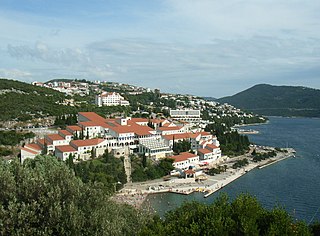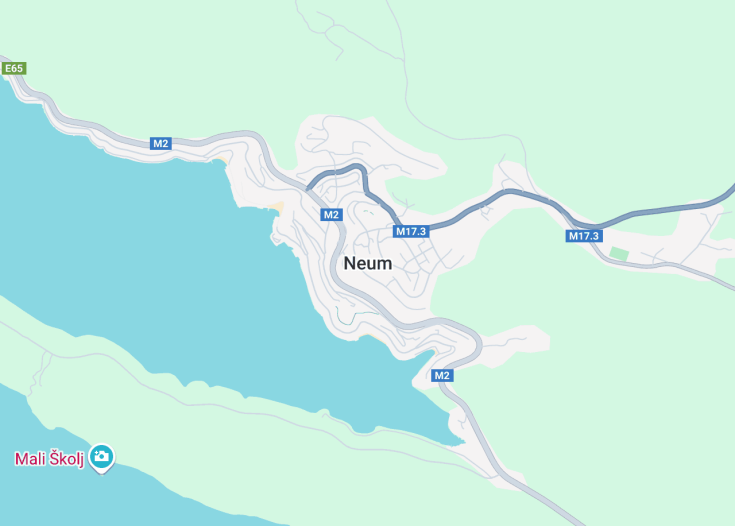Neum, nestled between Croatia’s Dalmatian coast and the hinterlands of Bosnia and Herzegovina, stands as the only coastal town in Bosnia, boasting a mere 24.5 kilometers of Adriatic shoreline. This seaside enclave offers a unique blend, harmoniously merging Bosnian culture with Mediterranean charm. Visitors can enjoy sun-soaked beaches, vibrant local cuisine, and a range of water sports. Neum is a budget-friendly alternative to its pricier Adriatic neighbors, making it an appealing destination for travelers seeking a tranquil coastal retreat with rich cultural experiences.
To make the most out of your Neum visit, consider staying in local accommodations such as guesthouses or B&Bs to enjoy authentic Bosnian hospitality and delicious homemade meals.
Plan your trip during late spring or early autumn to enjoy Neum’s natural beauty with fewer crowds and pleasant weather, perfect for beach activities and exploring the town.
Top things to do & see in Neum
Select the following sights and activities to discover best tickets and tours available in Neum.
Neum: A Coastal Gem in Bosnia and Herzegovina
| Country | Bosnia and Herzegovina |
| Time in Neum | GMT+1 |
| Language spoken | Bosnian |
| Population | 4,960 (2013 Census) |
| Currency | Bosnia and Herzegovina Convertible Mark (BAM, KM) |
| Airports |
|
Neum, the only coastal town of Bosnia and Herzegovina, stands uniquely positioned on the Adriatic Sea, offering a narrow window to the maritime front. Tucked between Croatia’s extensive coastline, Neum is a gateway splicing into the Dalmatian coast, characterized by its mild Mediterranean climate, scenic beaches, and vibrant cultural history. Described often as an accidental seaside alcove thanks to geopolitical happenstances, Neum enables Bosnia and Herzegovina access to the Adriatic, maintaining its maritime capabilities in a predominately mountainous region.
Historically, Neum played a pivotal role, serving as a crucial negotiating token in the complexities of the Balkan politics. Today, it leverages its geographical juxtaposition to boost tourism, acting as both a retreat for travelers seeking tranquility away from crowded Croatian resorts and a crucial economic zone for Bosnia and Herzegovina. Its development has been steady, emphasizing sustainable tourism practices while preserving its natural and architectural heritage. Neum’s economy thrives on tourism, supported by local businesses that range from quaint seafront hotels to authentic Bosnian cuisine restaurants.
The town’s architecture displays a mix of old-world charm and modernist Yugoslav-era buildings. Main attractions include its unspoiled beaches, the vibrant waterfront promenade, and the historical sites inland that tell tales of the region’s rich past. Neum is more than just a tourist spot; it’s a testament to Bosnia and Herzegovina’s resilience and cultural richness. Its festivals celebrating music and culture draw crowds from across the continent, mirroring the town’s diverse historical influences and its strategic importance over centuries.
Where is Neum?
Neum is located in the southern part of Bosnia and Herzegovina, snuggled between the Croatian peninsulas of Pelješac and Klek.
Distances:
| Route | Distance by car | Time by car |
|---|---|---|
| From Sarajevo to Neum | 143 miles / 230 km | Approx. 3 hours, 20 min |
| From Mostar to Neum | 44 miles / 71 km | Approx. 1 hour, 10 min |
| From Banja Luka to Neum | 223 miles / 360 km | Approx. 5 hours, 30 min |
What is Neum famous for?
Neum is famous for its stunning Adriatic coastline, often regarded as a quieter and more affordable alternative to the Croatian seaside resorts nearby. Additionally, its strategic location has historically made it a significant maritime passage in the region.
History
Prehistoric to Roman Era
Neum’s history dates back to prehistoric times, evidenced by the numerous caves and settlements where ancient artifacts have been found. During the Roman period, the area was part of the province of Dalmatia. Archaeological discoveries, including remnants of villas and fortifications, indicate that Neum was a bustling locality due to its strategic coastal position.
Medieval Period (7th – 15th Century)
The region of Neum was occasionally referenced in historical documents from the medieval period, particularly due to its involvement in the conflicts between the mighty empires and kingdoms like the Byzantine Empire and the Kingdom of Croatia. By the 15th century, Neum had come under the control of the Republic of Ragusa (now Dubrovnik), securing it as an important trading and maritime point on the Adriatic coast.
Ottoman Rule (1483 – 1878)
In 1483, Neum fell under the jurisdiction of the Ottoman Empire, which significantly influenced the cultural and architectural landscape of the area. This period saw the construction of various structures, including mosques and baths, which reflected Ottoman architectural style. Neum functioned as a vital outpost for the Ottomans, serving as a buffer zone against the Venetian Republic.
Austro-Hungarian Period (1878 – 1918)
With the Congress of Berlin in 1878, Neum was ceded to the Austro-Hungarian Empire. This epoch marked a significant transformation in the infrastructure and urban planning of Neum, including the expansion of maritime facilities and the introduction of modern architectural designs. The area saw improved road connectivity, boosting its appeal as a maritime hub.
20th Century to Present Day
Throughout the tumultuous 20th century, encompassing both World Wars and the eventual breakup of Yugoslavia, Neum experienced substantial political and social transformations. After the Bosnian War, Neum surfaced as Bosnia and Herzegovina’s only access point to the Adriatic Sea, enhancing its strategic significance yet again. Today, Neum is not only a historical treasure but also a growing tourist destination, boasting a blend of ancient charm and modern recreation.
Visit Neum
What to see and do in Neum
When visiting Neum, take time to explore its beautiful coastline with crystal clear Adriatic waters. Key attractions include:
- The Neum Beach, popular for its vibrant seaside promenade and water sports opportunities.
- Historic sites such as the Illyrian remains and Roman villas that offer a peek into the town’s ancient past.
- The rural hinterland, ideal for hiking and experiencing Bosnia and Herzegovina’s rural culture.
- Local culinary experiences, especially seafood delicacies unique to the Adriatic coast.
Neum also serves as a convenient base for day trips to nearby Dubrovnik in Croatia or Medjugorje, an important pilgrimage site.
Annual Events in Neum
Neum hosts several annual events that celebrate its culture and heritage. These include the Neum Animated Film Festival in the summer and the Neum Ethno Music Festival in early autumn. Additionally, the local summer carnival offers festivities with traditional music, dances, and foods, creating a lively atmosphere along the promenade.
Best time to visit Neum
The ideal time to visit Neum is between late spring and early autumn, particularly from May to September. During these months, the weather is warm and conducive for swimming, sunbathing, and other outdoor activities.
Is Neum worth visiting?
Neum is definitely worth a visit for anyone interested in exploring a lesser-known Mediterranean destination. This small town not only offers stunning beach leisure but also serves as a cultural bridge between Eastern and Western Europe with its rich history and eclectic influences. Whether you are a history buff, a lover of nature, or simply in search of a tranquil seaside retreat, Neum provides a unique blend of attractions that are both enriching and uniquely Bosnian.










